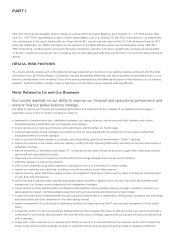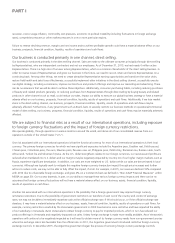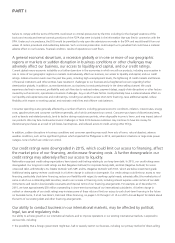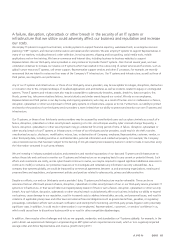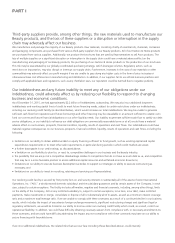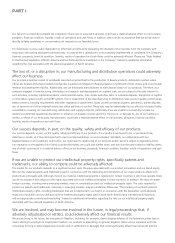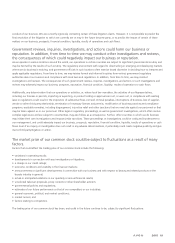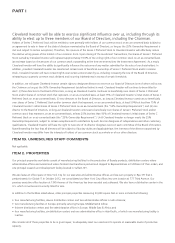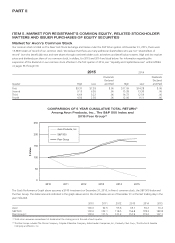Avon 2015 Annual Report Download - page 29
Download and view the complete annual report
Please find page 29 of the 2015 Avon annual report below. You can navigate through the pages in the report by either clicking on the pages listed below, or by using the keyword search tool below to find specific information within the annual report.Our ability to utilize our foreign tax and other U.S. credits to offset our future taxable income
may be limited under Sections 382 and 383 of the Internal Revenue Code.
As of December 31, 2015, we had approximately $746.1 million of foreign tax and other credits available to offset future income for
U.S. federal tax liability purposes. Our ability to utilize such credits to offset future income could be limited, however, if the Company
undergoes an “ownership change” within the meaning of Section 382 of the Internal Revenue Code of 1986, as amended (the “Code”). In
general, an ownership change will occur if there is a cumulative increase in ownership of our stock by 5% shareholders (as defined in the
Code) that exceeds 50 percentage points over a rolling three-year period. If the 50 percentage points are exceeded, Section 382 establishes
an annual limitation on the amount of deferred tax assets attributable to previously incurred credits that may be used to offset taxable
income in future years. A number of complex rules apply in calculating this limitation, and any such limitation would depend in part on the
market value of the Company at the time of the ownership change and prevailing interest rates at the time of calculation. As a result, the
magnitude of any potential limitation on the use of our deferred tax assets and the effect of such limitation on the Company if an ownership
change were to occur is difficult to assess. However, if all or a portion of our deferred tax assets were to become subject to this limitation,
our tax liability could increase significantly and our future results of operations and cash flows could be adversely impacted.
We currently believe an ownership change has not occurred. However, in recent periods, we have experienced fluctuations in the market
price of our stock and changes in ownership by our 5% shareholders. In addition, the Investment Transaction (as defined below) will result in
an increase in our cumulative ownership change by our 5% shareholders.
Significant changes in pension fund investment performance, assumptions relating to pension
costs or required legal changes in pension funding rules may have a material effect on the
valuation of pension obligations, the funded status of pension plans and our pension cost.
Our funding policy for pension plans is to meet the minimum required contributions under applicable law and accumulate plan assets that,
over the long run, are expected to approximate the present value of projected benefit obligations. Our pension cost is materially affected by
the discount rate used to measure pension obligations, the level of plan assets available to fund those obligations at the measurement date
and the expected long-term rate of return on plan assets. Significant changes in investment performance or a change in the portfolio mix of
invested assets can result in corresponding increases and decreases in the valuation of plan assets, including equity and debt securities and
derivative instruments, or in a change of the expected rate of return on plan assets. Also, while our U.S. defined benefit pension plan has
been closed to employees hired on or after January 1, 2015, significant changes in the number and demographics of participants in our
pension plans generally may result in changes to our funding obligations. A change in the discount rate would result in a significant increase
or decrease in the valuation of pension obligations, affecting the reported funded status of our pension plans as well as the net periodic
pension cost in the following fiscal years. Similarly, changes in the expected rate of return on plan assets can result in significant changes in
the net periodic pension cost of the following fiscal years. Please see “Transfer of certain U.S. pension obligations and related assets in
connection with the Separation may have a material adverse effect on the funded status of our U.S. defined benefit pension plan and our
pension funding obligations in respect of our retained pension liabilities” below for additional information regarding the risks on the U.S.
defined benefit pension plan associated with the planned separation of the North America business. Please see “Critical Accounting
Estimates – Pension and Postretirement Expense” within MD&A on pages 32 through 34 and Note 11, Employee Benefit Plans on pages
F-34 through F-42 of our 2015 Annual Report, for additional information regarding the impact of these factors on our pension plan
obligations.
Any strategic alliances or divestitures may expose us to additional risks.
We evaluate potential strategic alliances that would complement our current product offerings, increase the size and geographic scope of
our operations or otherwise offer growth and/or operating efficiency opportunities. Strategic alliances may entail numerous risks, including:
• substantial costs, delays or other operational or financial difficulties, including difficulties in leveraging synergies among the businesses to
increase sales and obtain cost savings or achieve expected results;
• difficulties in assimilating acquired operations or products, including the loss of key employees from any acquired businesses and
disruption to our direct-selling channel;
• diversion of management’s attention from our core business;
• adverse effects on existing business relationships with suppliers and customers;
• risks of entering markets in which we have limited or no prior experience; and
• reputational and other risks regarding our ability to successfully implement such strategic alliances, including obtaining financing which
could dilute the interests of our shareholders, result in an increase in our indebtedness or both.
A V O N 2015 17
7553_fin.pdf 19



